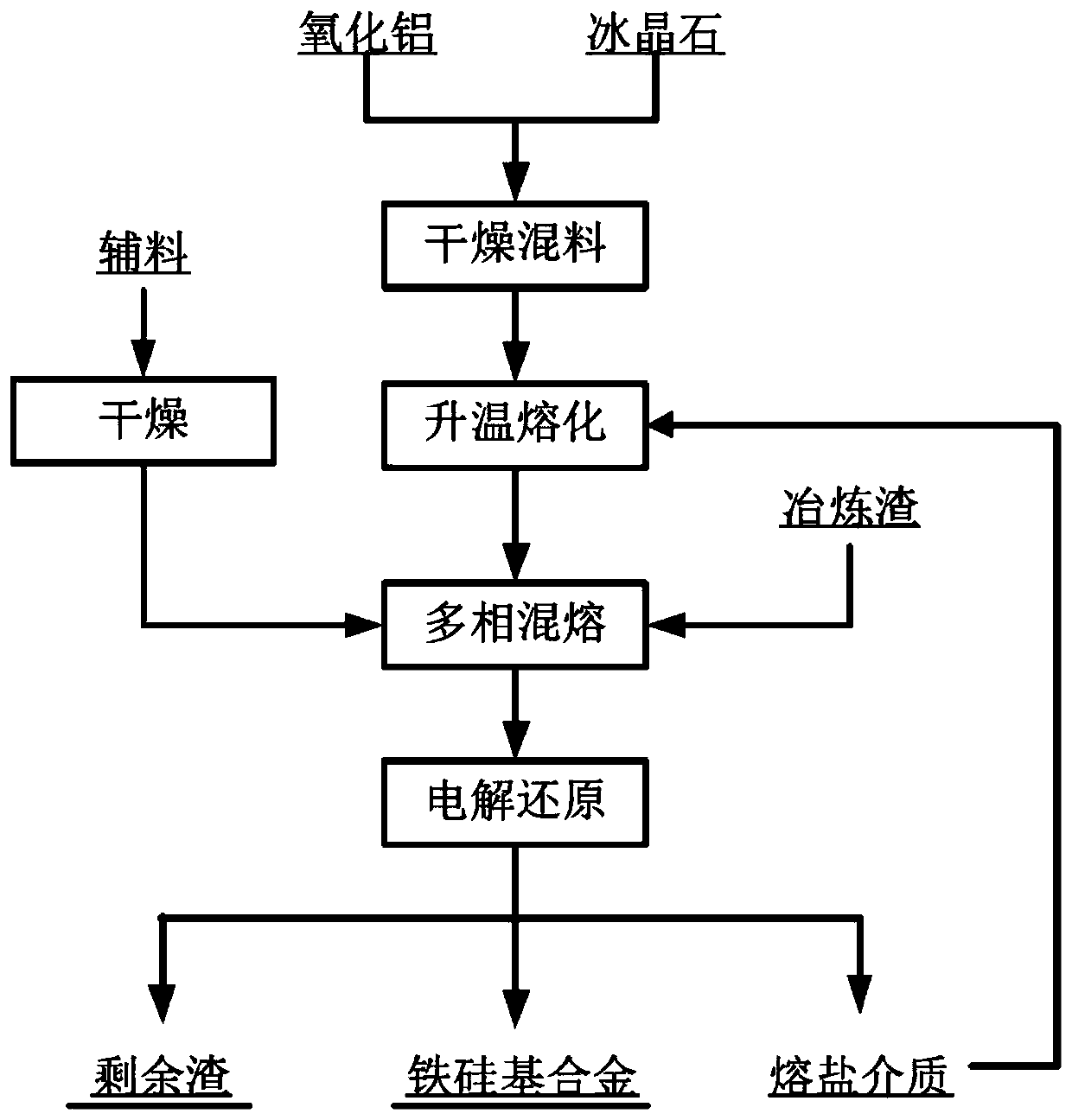Method for treating smelting slag through electrolytic reduction of molten aluminum salt
A molten salt electrolysis device and molten salt electrolysis technology are applied in the field of using aluminum molten salt electrolytic reduction to treat smelting slag. The process is controllable, the waste residue is greatly reduced and recycled, and the consumption of raw materials is less.
- Summary
- Abstract
- Description
- Claims
- Application Information
AI Technical Summary
Problems solved by technology
Method used
Image
Examples
Embodiment 1
[0055] First dry and dehydrate the raw materials except smelting slag until the water weight content is less than 0.1%, then mix the aluminum molten salt (95% cryolite and 5% alumina by mass fraction respectively) and put it into the fume collection hood In the aluminum electrolytic cell, the temperature is raised to 700 ° C, and then calcium chloride, aluminum fluoride, sodium hydroxide and calcium carbonate are added to the electrolytic cell in sequence, and the auxiliary materials mixed with calcium carbonate and molten copper converter slag containing iron and silicon are added. Copper converter slag, aluminum molten salt and auxiliary materials account for 10%, 80% and 10% of the mass fraction of the total charge respectively; 30%, 5%, 40%, 25%;
[0056] Using graphite as anode and cathode materials, maintain a constant temperature of 1300°C and control the tank pressure of 2.0V to carry out molten salt electrolysis for 1 hour; after the reaction is completed, the bottom ...
Embodiment 2
[0059] First dry and dehydrate the raw materials except smelting slag until the water weight content is less than 0.1%, and then mix the aluminum molten salt (cryolite with a mass fraction of 65% and alumina with a mass fraction of 35% respectively) and put it into a fume collection hood The aluminum electrolytic cell is heated to 600°C, and then the mixed auxiliary materials and the mixed smelting slag of molten steelmaking converter slag and blast furnace slag are added to the electrolytic cell in sequence (the mass ratio of steelmaking converter slag and blast furnace slag is 1:1 ), the molten mixed smelting slag, aluminum molten salt and auxiliary materials account for 80%, 15% and 5% of the mass fraction of the entire charge respectively; the auxiliary material components are sodium chloride and aluminum chloride mixture (sodium chloride and aluminum chloride mass ratio is 1:1), magnesium fluoride, potassium hydroxide, sodium carbonate and potassium carbonate mixture (mass...
Embodiment 3
[0063] First dry and dehydrate the raw materials except smelting slag until the water weight content is less than 0.1%, and then mix the aluminum molten salt (cryolite with a mass fraction of 75% and alumina with a mass fraction of 25% respectively) and put it into a fume collection hood In the aluminum electrolytic cell, the temperature is raised to 650 ° C, and then the mixed auxiliary materials and the red mud formed by aluminum smelting are added to the electrolytic cell in sequence, and the mass fraction of the red mud, aluminum molten salt and auxiliary materials accounted for 10% of the total feeding materials is respectively , 10% and 80%; the auxiliary material components are a mixture of magnesium chloride and potassium chloride (the mass ratio of magnesium chloride and potassium chloride is 1:1), a mixture of aluminum fluoride and calcium fluoride (the mass ratio of aluminum fluoride and calcium fluoride ratio of 1:1), calcium hydroxide, sodium carbonate and calcium ...
PUM
| Property | Measurement | Unit |
|---|---|---|
| specific heat capacity | aaaaa | aaaaa |
Abstract
Description
Claims
Application Information
 Login to View More
Login to View More - R&D
- Intellectual Property
- Life Sciences
- Materials
- Tech Scout
- Unparalleled Data Quality
- Higher Quality Content
- 60% Fewer Hallucinations
Browse by: Latest US Patents, China's latest patents, Technical Efficacy Thesaurus, Application Domain, Technology Topic, Popular Technical Reports.
© 2025 PatSnap. All rights reserved.Legal|Privacy policy|Modern Slavery Act Transparency Statement|Sitemap|About US| Contact US: help@patsnap.com

